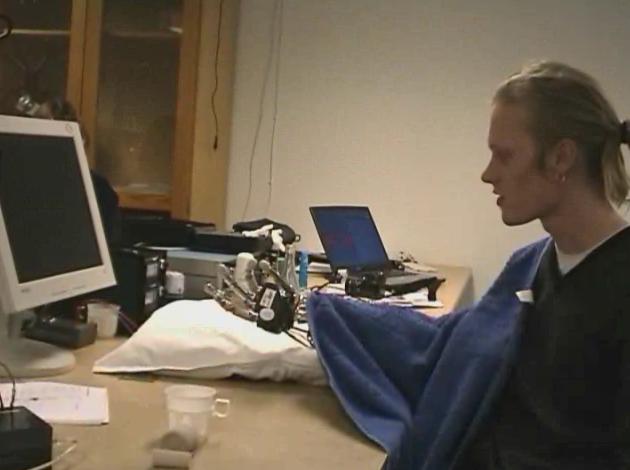A brain-machine interface developed in collaboration with Tel Aviv University led to a breakthrough that allowed Gidam from Sweden to feel his fingers again, even though they, like most of his hand, were amputated, and was able to perform complex tasks such as eating and writing after a short training

Scientists from a number of universities from Europe in collaboration with Tel Aviv University managed to connect neural commands in the amputated arm of a disabled person to a prosthesis that allowed him to perform complex actions such as eating and writing. Recently he also began to feel the touch thanks to sensors installed in the fingers of the prosthetic hand.
The project is led by Prof. Fredrik Sebelius, and Prof. Thomas Laurell from Lund University in Sweden and Prof. Göran Lundborg from Malmo University Hospital in Sweden. The first patient of the group is Robin A. Anxtam af Ekenstam) from Sweden and according to Prof. Yossi Shachem-Diamond from the Department of Engineering at Tel Aviv University, the team succeeded in wiring Ansam's brain to the SmartHand. The "SmartHand" device resembles a real hand in its function, sensitivity and appearance.
Link between brain and machine
Prof. Shaham-Diamond's contribution to the project in which Tel Aviv University is a partner with Lund University in Sweden, is the interface between nerves in the body and electronic devices. "There are functioning nerves remaining in the damaged area of the amputated limb," says Shaham. "Our team builds an interface between the machine and the nerve in the arm, and connects the field of cognitive neuroscience to a first-class information technology system."
Prof. Shaham is the director of the laboratory that studies the field of the interface between nanotechnology and biotechnology. The laboratory in the Department of Electrical Engineering and Physical Electronics deals with nanoscale information technologies. "Our challenge was to produce electrodes that, in addition to being flexible, could remain in the human body and function well for at least 20 years."
With the help of the team from Uni' Tel Aviv, in collaboration with the Tyndall Research Institute in Cork, Ireland, the smart hand project managed to combine the advantages of the intelligent prosthetic hands together with the basic features of a flesh and blood hand. For this purpose, the scientists used four electric motors and 40 sensors that work when the smart hand touches any bone, not only for the purpose of replacing the movements of the human hand but also to provide the subject with the same feeling of touch.
The smart artificial hand will remain in Aknestam's possession as long as he wishes. "After a short training series, he used the artificial knowledge as if it were his natural hand," said Prof. Shaham. "Tactile sensors were also built into the hand, so that the transfer of information is two-way. This allows Ekanstam to perform complicated activities such as eating and writing."
In an interview with Swedish television, Eknestam said: "I'm using muscles that I haven't used in years. If I hold hard objects I feel it in my fingertips, which is strange for me, since I don't have fingers. This is an amazing system."
The multi-million dollar project, in which in addition to researchers from Tel Aviv and Sweden, also researchers from Italy, Denmark, Iceland and Ireland, is supported by the sixth framework program for research and development of the European Union. According to Shaham, "The fingers are the most complex appendages that the human body has" says Prof. Shaham. "The brain is required to synchronize the movement of each finger in a complicated way." While the prototype looks pretty basic, the scientists plan to equip the smart hands that will be built in the future with an artificial skin that will give the brain feedback from additional sensors. Later, the smart hand will be attached to the body of additional stumps and the researchers will try to understand with their help how the device can be improved.
Project website: http://www.smarthand.org

9 תגובות
If you are enthusiastic about this, you should take a look at another project by Prof. Shaham - ReNaChip, where they are trying to replace brain tissue with a computer and connect it back to the brain
http://www.renachip.org/
It really is a bomb
What is "Valery Knock"?
Another small step towards eternal life
Stunning!!
On the way near a full bionic.
But I am more in favor of the development of tissue engineering for these needs, i.e. solutions of growing whole biological organs for the amputees using stem cells developed from their body cells for example.
The bionic hand on the other hand (and not just a hand) is essential in my opinion for future robots. for any benefit.
That's pretty much my dad!!!!!
Cool
To Eran, this would also be technologically possible, I would not choose the lives of those people in the film Surrogate. Seems like a pretty depressing life to me. And for the subject of the article, this is a far-reaching breakthrough that also has medical implications, but no less than that, deep philosophical implications.
After the problems of the amputees of the world's rich are solved, theoretically it will be possible to record the sensations (that is, to record the communication that passes through the nerves) and transfer it to something that is outside the body, and when the same object touches something the same sensations will be transmitted back to the body - surprisingly, theoretically today there is Basic technological infrastructure to develop something similar to what was in the new Bruce Willis movie Surrogate. We will lie at home all day while robots collecting sensations will throw information at us.